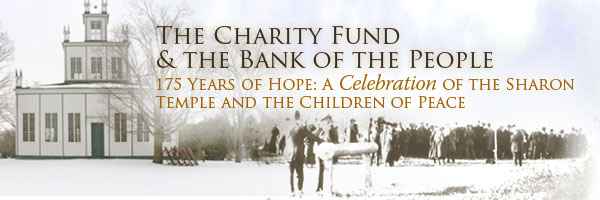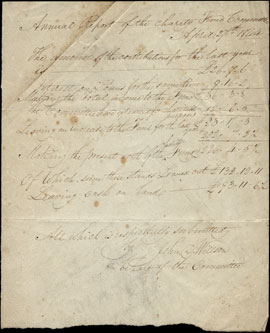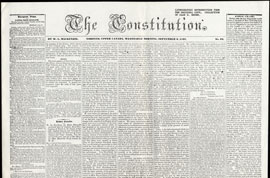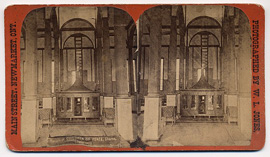
Table of Contents
Today, we recognize the importance of “micro-credit” to aid the poor in developing countries. Relatively small sums loaned to people without credit provides security and a “hand up” instead of a “hand out.”
The same was true in early Ontario, where small farmers had to depend on the sale of a single crop – wheat – that was frequently shut out of British markets.
(Sharon Temple Museum Archives)

Click to see a larger image (136K)
Charity Fund report, 1844
Children of Peace collection
Reference Code: F 4177-2
Archives of Ontario
In 1832, the Farmers’ Store unsuccessfully attempted to transform itself into a bank, although this was stymied by the legislature. It already allowed its members to borrow money against the value of their stock, with repayment in wheat. At that time, the Store was led by Samuel Hughes, an elder in the Children of Peace.
In that same year the Children of Peace transformed their Charity Fund, composed of alms collected in the temple, into a credit union. The elders proposed that the surplus in the charity fund be loaned at interest to members. Since they controlled the loan process themselves, they could ensure that terms were manageable, that no one was denied credit, and that the repayment of the principal remained flexible in difficult times.

Click to see a larger image (68K)
Front page, Constitution newspaper
Newspapers collection
Reference Code: L 23
Archives of Ontario
The Constitution was founded by William Lyon Mackenzie on July 4th,
1836, in an effort to organize the democratic reformers of Upper
Canada. It was funded with a loan from the Bank of the People.
By 1833, a “poor farmer of East Gwillimbury” (where the village of Hope lay) wrote to William Lyon Mackenzie’s Colonial Advocate calling on the legislature to create a “Provincial Loan Office” in which farmers could borrow small sums guaranteed by their land holdings. This became the first petitioning campaign of the newly formed reform political organization, the Canadian Alliance Society in 1835. Both David Willson and Samuel Hughes were to play a large roll in the creation of that political organization, and in determining its economic policies.
The “Loan Office” eventually took shape as the Bank of the People in 1836 by the political reform movement. David Willson and the Children of Peace were among its 56 stockholders. The new bank was soon to prove its distinctiveness.
Despite offering 5% interest on deposits, it was able to deliver a 6% dividend in 1837, in spite of paying off £1,200 in start-up costs. It managed to do this despite the general economic downturn, and without resorting to jailing its delinquents. The only loan made by the bank for which any details exist is one for £275 by William Lyon Mackenzie to start his new newspaper, the Constitution, in July 1836, by which he renewed his attacks on the despotic Family Compact ruling the province.
